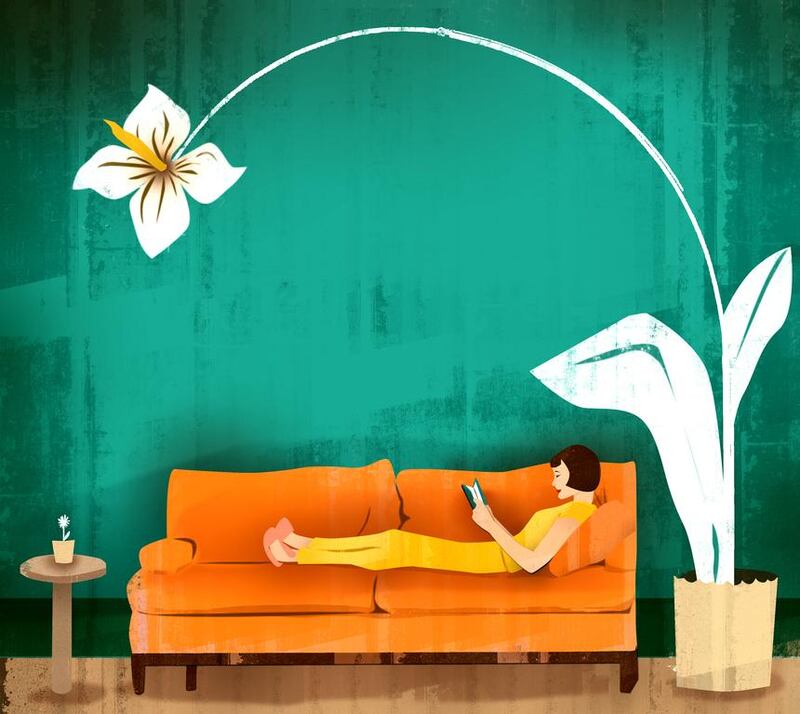Adding life to your decor is incredibly simple – all you need to do is head to your local garden centre. Plants shouldn’t be viewed as independent from the rest of your interior; they can be a striking feature themselves. They’re an incredibly versatile design tool; they make great focal pieces; add texture and interest; and because there are so many varieties, there’s something for every scheme.
Plants also have benefits you can’t see with your eyes. They can purify the air, regulate humidity, reduce carbon dioxide and increase oxygen in the air. And studies have shown that they’re great for our emotions, helping to reduce stress levels.
First steps
There are a few things to consider before you start buying. The first – as always with decorating – is size. There’s no point investing in a palm that will end up swamping a narrow hallway, for example. If in doubt, check the label, where you should find the final height and width the plant will grow to.
On the same label, you’ll also find directions as to what conditions your plant needs to thrive, such as optimum light and temperature levels. Have an idea where you hope to place your plants before you set off – there’s no point putting a shade lover on your windowsill or a hothouse plant in a cool draft – you’ll soon find they complain.
Finally, unlike all your other design features, these ones will require some work. There will be instructions on the label about watering and feeding your plant. Some are straightforward and just need an occasional top-up, while others require regular doses of nutrients and even spraying to keep leaves happy – so think about how much time and effort you’re willing to invest.
Selecting your style
Having narrowed your selection to those plants that will survive in your home, it’s time to have fun and choose for your personal style and taste. There are so many options, from soft, fluffy ferns to structured architectural plants like the giant yucca, delicate flowering species such as orchids and functional ones like herbs (essential for any foodie).
Think about the effect you’d like to achieve. If you have a room with lots of hard edges that need softening, a gently tactile plant like a Boston fern would be ideal, or play up the strong lines with a sharp, spiky Dracaena.
Also think about the style of your existing decor and what will be suited to it. Hydrangeas, for example, ooze vintage charm, while rubber plants have a distinctly 1970s retro vibe. Ornamental citrus trees bring a flavour of the Mediterranean.
Creating good groups
A large plant on its own makes an ideal focal point – try an ornamental areca palm, exotic vriesea or even a mature bonsai – but smaller plants are best in groups, so they don’t get lost. You can structure these into rows on a mantle, shelf or windowsill (making sure to stick to uneven numbers, which are visually more appealing) or style more relaxed groupings of different types of plants.
There’s some skill to creating a successful plant group, so don’t be afraid to experiment and move things around. The key elements to consider are:
• Height: Vary this on at least three levels, making sure the grouping looks balanced from all angles.
• Colour: Stick within a palette for greatest effect – for example, foliage with silver-grey tones or flowers from the warm side of the colour wheel.
• Texture: Mix up hard and soft, rounded and spiky, large and small leaves to create tension and drama in your grouping.
A question of pots
All plants need good drainage so the roots don’t get waterlogged. You can either choose a pot with a hole at the bottom and a tray to prevent water leaking out onto your surfaces or leave the plant in a cheap plastic pot and sit that inside a decorative pot, so you can lift it out to check water isn’t pooling.
In terms of colour, shape and finish, your choice of pots is virtually endless. If you’re planning on grouping several plants together, think about whether you want the pots to match or whether you’d prefer a more eclectic look. Sticking within a restricted palette will help create a toned look that is pleasing on the eye.
Small pots are particularly versatile, as they’re so easy to move. You might start out with a trio of begonias on your windowsill that can be transferred to your dining table to make a quick and simple centrepiece for a dinner party.
Trend alert
Plants have fashions. At the moment, succulents are very much en vogue. These are a great choice if you’re not confident about how green your fingers are – they store water in their leaves, stems and roots, making them ideal for hot climates and people who might forget to water them.
Plant walls are big news and create a really dramatic statement. You'll need to invest in a dedicated hydroponic system from a specialist such as the Dubai-based Vertical Greens (www.verticalgreensuae.com) so as not to end up with damp problems, but if you have the budget, then it's worth it for the sheer wow factor.
Maintenance
We’ve already talked about how different plants have different needs, so do your research and learn about what your chosen species prefer in terms of light, water and food. Try to make watering in particular a regular chore, ideally on the same day(s), so you don’t forget.
If that doesn’t work, you might want to invest in a self-watering system – it’s ideal for holidays, too. There are also sensors you can stick directly into the soil that will alert you when the moisture content dips below what it should be. And you can download an app like Waterbug or House Plants, which will remind you to water and feed your plants at specific times.
If you’re really worried, start simple – an air plant doesn’t need soil and will take its moisture and nutrients from the air, so all it really needs is a room with decent circulation and a monthly feed spray during the spring and summer months.
Finally, if you do lose a plant or two, don’t worry. Keep persevering; green fingers can be developed with practice.
weekend@thenational.ae
Follow us @LifeNationalUAE
Follow us on Facebook for discussions, entertainment, reviews, wellness and news.










